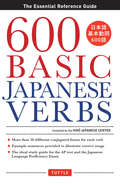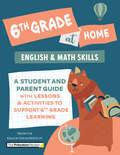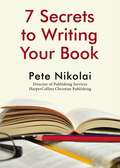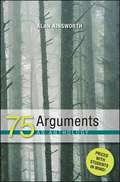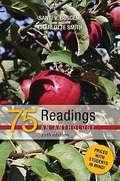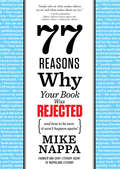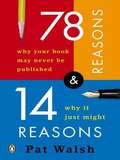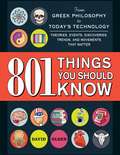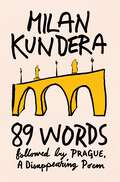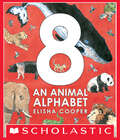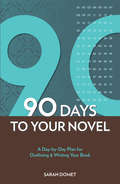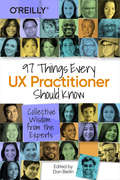- Table View
- List View
58-IN-MIND: Multilingual Teaching Strategies for Diverse Deaf Students
by Debbie Golos; Marlon Kuntze; Kimberly Wolbers; Chris KurzA highly practical and engaging resource for current and future teachers, 58-IN-MIND describes and demonstrates theoretically-driven, research-based, and classroom-tested best practices for using American Sign Language and English in instruction across the curriculum. The multilingual and multimodal instructional strategies presented here are embedded in approaches that aid learning and foster well-being. This book will support teachers in creating meaningful educational experiences for Deaf students in all grades, from early childhood education through high school. Each chapter is written by a team of researchers and P–12 teachers with at least one Deaf coauthor. With seventy-five percent of the authors being Deaf, this is the first teaching methods book to harness the expertise of Deaf professionals at this level, highlighting their vital role in Deaf education and in shaping inclusive and effective learning environments. This book meets the need for a resource that recognizes the diversity of Deaf students by creating space in the classroom to honor their home/heritage languages, cultures, races, genders, abilities, hearing levels, and other multiple and intersecting identities. Written in a conversational tone, the book includes core recommendations for instruction of the targeted subject area, examples of key strategies, lessons and real stories from those working in the field, suggestions for practice, and recommended resources. “58-IN-MIND” in the title refers to the version of the ASL sign "stick" that is made on the forehead, which is equivalent to the English idiom “to stick in one's mind.” As in, when students learn in a culturally responsive manner, the learning is likely to stick. The title also alludes indirectly to the collective aspirations of the chapter authors that the practices discussed in the book will also stick in the readers’ minds, and thus have a transformative impact on the way Deaf students are taught.
5th Grade at Home: A Student and Parent Guide with Lessons and Activities to Support 5th Grade Learning (Math & English Skills) (Learn at Home)
by The Princeton Review5TH GRADE AT HOME offers simple, guided lessons and activities that students and their parents can use to help keep grade-appropriate English and math skills on track.With the perfect mix of practical lessons and hands-on activities, the Learn at Home series helps keep kids engaged and up-to-date—no matter where class is held. Written to bolster independent learning, this student-centric workbook includes parent tips and simple support to help keep kids&’ education on track. • Guided help for key 5th grade English and math topics • Skills broken into short, easy-to-accomplish lessons • Modules designed to encourage students to dive in, explore, and engage in interactive learning • Fun at-home learning activities using common household items • Parent tips to contextualize lessons and help assist your child 5th Grade at Home covers key grade-appropriate English and math topics such as: • grammar • vocabulary • reading comprehension • writing • number families & lines • multiplication & divison • fractions & ratios • factors & primes • time, distance, and money problems... and more!
60 Strategies for Improving Reading Comprehension in Grades K-8
by Kathleen F. JonsonThis ready-to-use tool kit of fun and functional strategies, based on the National Reading Panel Report, helps teach the most difficult piece of the reading process: comprehension.
600 Basic Japanese Verbs
by Hiro Japanese Center600 Basic Japanese Verbs is a handy, easy-to-use guide to one of the building blocks of Japanese grammar--verbs.This book will be an essential resource for students wishing to learn Japanese as it shows how to conjugate the 600 most common Japanese verbs quickly, and with very little effort. This is the only guide to list all verb forms in both Japanese script and romanized form.Compiled by Japanese language experts at The Hiro Japanese Center, more than 30 different verbal forms are given for each verb including all forms used in contemporary spoken, written, formal and conversational Japanese.Key features of this book are: Includes all the most useful verbs and Kanji (logographic Chinese characters) in Japanese, including less common ones. A wealth of example sentences are given to demonstrate correct verb usage. Over 30 forms are given for each verb including polite or formal, plain, negative, potential, conditional, passive, causative, and many more. Both Kana, Japanese script, and romanized forms are given for each entry. An ideal study guide for the standard Advanced Placement college test and the Japanese Language Proficiency Exam. Special sections are devoted to compound verbs and suru verbs such as Kaimono suru (to shop).
600 Basic Japanese Verbs: The Essential Reference Guide
by Hiro Japanese Center600 Basic Japanese Verbs is a handy, easy-to-use guide to one of the building blocks of Japanese grammar--verbs.This book will be an essential resource for students wishing to learn Japanese as it shows how to conjugate the 600 most common Japanese verbs quickly, and with very little effort. This is the only guide to list all verb forms in both Japanese script and romanized form.Compiled by Japanese language experts at The Hiro Japanese Center, more than 30 different verbal forms are given for each verb including all forms used in contemporary spoken, written, formal and conversational Japanese.Key features of this book are: Includes all the most useful verbs and Kanji (logographic Chinese characters) in Japanese, including less common ones. A wealth of example sentences are given to demonstrate correct verb usage. Over 30 forms are given for each verb including polite or formal, plain, negative, potential, conditional, passive, causative, and many more. Both Kana, Japanese script, and romanized forms are given for each entry. An ideal study guide for the standard Advanced Placement college test and the Japanese Language Proficiency Exam. Special sections are devoted to compound verbs and suru verbs such as Kaimono suru (to shop).
6th Grade Social Studies: Latin America, Caribbean, Canada, Europe, Australia (Georgia)
by Carole MarshYou are going to learn all about the geography, history, people, economics, government, and citizenship (and a few other fun things!) of important world regions. As you progress through the sixth grade, you will discover that learning about other countries helps you understand (and appreciate!) your own country.
6th Grade at Home: A Student and Parent Guide with Lessons and Activities to Support 6th Grade Learning (Math & English Skills) (Learn at Home)
by The Princeton Review6th Grade at Home offers simple, guided lessons and activities that students and their parents can use to help keep grade-appropriate English and math skills on track. With the perfect mix of practical lessons and hands-on activities, the Learn at Home series helps keep kids engaged and up-to-date—no matter where class is held. Written to bolster independent learning, this student-centric workbook includes parent tips and simple support to help keep kids&’ education on track. • Guided help for key 6th grade English and math topics • Skills broken into short, easy-to-accomplish lessons • Modules designed to encourage students to dive in, explore, and engage in interactive learning • Fun at-home learning activities using common household items • Parent tips to contextualize lessons and help assist your child 6th Grade at Home covers key grade-appropriate English and math skills including: • reading comprehension • writing, essays, and literary elements • major parts of speech • vocabulary, grammar, and editing • fractions, percents, ratios, and proportions • mean, median & mode • early algebra • equations & inequalities • graph literacy and more!
7 Keys to Comprehension: How to Help Your Kids Read It and Get It!
by Susan Zimmermann Chryse HutchinsIt's simple: If children don't understand what they read, they will never embrace reading. And that limits what they can learn while in school. This fact frightens parents, worries teachers, and ultimately hurts children. 7 Keys to Comprehension is the result of cutting-edge research. It gives parents and teachers--those who aren't already using this valuable program--practical, thoughtful advice about the seven simple thinking strategies that proficient readers use: * Connecting reading to their background knowledge * Creating sensory images * Asking questions * Drawing inferences * Determining what's important * Synthesizing ideas * Solving problems Easily understood, easily applied, and proven successful, this essential educational tool helps parents and teachers to turn reading into a fun and rewarding adventure.
7 Secrets to Writing Your Book
by Pete NikolaiHave you started writing a nonfiction book that you are struggling to finish? Do you have an idea for a book but don't know how to get started?Now you can start and finish your book sooner rather than later following an easy 7 step process that forms the foundation for the way many nonfiction books are written.This insider's guide starts by helping you find the time to write your book and then walks you through creating your book proposal, developing your writing plan, and writing your first draftAlong the way you'll determine when you could finish your book based on your personal writing output and the time you have available to write. You'll also discover the 7 secrets to finishing your book sooner rather than later including how to transform your dreams into your vision and how to establish the goals and action steps needed to make your vision a reality.Writing a book is similar to taking a journey. Having a plan and putting in the necessary time gets you from where you are to where you want to be. The 7 Secrets to Writing Your Book takes you step-by-step through the process of developing your plan and following through to write your book sooner rather than later.If you're ready to finish your book and to begin to see the impact it has in the lives of others, then read this quick guide and take the steps to make it happen!
7 Steps to Raising a Bilingual Child
by Steven Parker Naomi Steiner Susan HayesFind out why early childhood is the best time to teach your child a second language and learn how to do it with this step-by-step guide.The best time to learn a second language is as a child. During childhood, the brain is more receptive to language learning than at any other time in life. Aware that a second language can enrich their child's understanding of other cultures and bring future job opportunities in a world drawn ever closer by globalization, many parents today are motivated to raise their children bilingual.7 Steps to Raising a Bilingual Child helps parents in both monolingual and multilingual families determine and achieve their bilingual goals for their child, whether those goals are understanding others, the ability to speak a second language, reading and/or writing in two languages, or some combination of all of these. The authors will:explain how the brain learns more than one language,explode common myths,address frequently asked questions,and reveal an array of resources available to families.Packed with insightful anecdotes and powerful strategies, 7 Steps to Raising a Bilingual Child is a one-of-a-kind guidebook for those seeking to provide their children with a uniquely valuable experience.
70 Hebrew Words Every Christian Should Know
by Matthew Richard SchlimmThe basic message of the Bible can be understood in any language. At the same time, many biblical texts are hard to understand because they don’t quite make sense when translated into English. Something is missing. Quite frequently, what readers miss has been lost in translation. Maybe there is a pun or wordplay in the original. Sometimes names like Adam, Eve, Cain, Abel, and Eden just seem like names to us but have meanings that are essential to the story. Many Hebrew words have multiple meanings, but the English translators have to just pick one (for example, the same Hebrew word can mean both hear and obey). Even more common are Hebrew words that have much wider meanings than their English translations. A few examples are the Hebrew words rendered as remember, covenant, walk, gates, love, cleanliness, holiness, glory, wisdom, and fear. The original language allows various parts to click together like well-constructed puzzle pieces. With Hebrew in mind, interpreters see new details they didn’t realize were missing before. They make new connections. They immerse themselves in scripture more fully.That’s where this book comes in. Learning a language is like learning a worldview. Those who learn biblical Hebrew can better understand not only what biblical authors wrote, but also how they thought. Unfortunately, those insights come only after years of study. This book is about getting right to the important, exciting insights. It’s an opportunity to be transformed by the renewing of our minds as we better understand how biblical authors used their language to express their experience of God and the world.If you are just beginning to study Hebrew and want the insights and motivation to continue or if you have no intention of learning biblical Hebrew but want to better understand the Bible, this book is for you!
75 Arguments: An Anthology
by Alan AinsworthA collection of seventy-five extensively taught arguments--on national security, technology, marriage, race, economics, the environment, and globalization--is sure to engage students and inspire them to think critically and write well.
75 Readings: An Anthology
by Charlotte Smith Santi V. Buscemi75 Readings introduces students to a range of classic and contemporary essays. The text also exposes them to a variety of rhetorical strategies, writing styles, themes, and topics. At the same time, it retains maximum flexibility for the instructor. These essays provide good structural models for rhetorical techniques and raise complex questions about current and enduring issues.
75 Readings: An Anthology (Eleventh Edition)
by Charlotte Smith Santi V. Buscemi75 Readings offers an outstanding collection of the most popular essays for first-year writing. The readings represent a wide variety of authors, disciplines, issues, and interests.
77 Reasons Why Your Book Was Rejected
by Mike NappaA straightforward, practical reference for aspiring authors, 77 Reasons Why Your Book Was Rejected details the various reasons why editors and agents reject book ideas and pinpoints the mistakes that writers most often make in their proposals. This is an engaging resource for aspiring writers, delivering insider information on why editors and agents decline books and, more importantly, how to get them to stop passing on yours.
78 Reasons Why Your Book May Never Be Published and 14 Reasons Why It Just Might
by Pat WalshFor the hundreds of thousands who buy writers’ guides every year, at last there’s one that tells the ugly truth: writers who can’t get published are usually making a lot of mistakes. This honest, often funny, book shows them how to identify their own missteps, stop listening to bad advice, and get to work. Drawing on his experience as founding editor of MacAdam/Cage, Pat Walsh gives writers what they need—specific, straightforward feedback to help them overcome bad habits and bad luck. He avoids the optimistic, sometimes misleading directions often found in publishing how-to books and presents the industry as it is, warts and all. Here is the first guide that tells writers just what the odds against them are and gives them practical tips for evening them.
801 Things You Should Know
by David OlsenDiscover how the world's biggest ideas, inventions, and actions changed the course of history! What would life be like if the Age of Reason never challenged others to think differently, if the Industrial Revolution never happened, or if the New York Stock Exchange never came into existence? 801 Things You Should Know gives you the lowdown on thoughts and events that transformed past civilizations into the cultures that we know today. Each entry explains a game-changing concept or moment in time, detailing how it helped shape societies around the globe. You'll uncover fascinating details you'd never heard before, and be surprised to learn how these major influences have directly impacted the way you live. From the sixth century B.C. to the present day, you'll discover the captivating people, acts, and ideas that have inspired change--and revolutionized the world.
801 Things You Should Know
by David OlsenDiscover how the world's biggest ideas, inventions, and actions changed the course of history! What would life be like if the Age of Reason never challenged others to think differently, if the Industrial Revolution never happened, or if the New York Stock Exchange never came into existence? 801 Things You Should Know gives you the lowdown on thoughts and events that transformed past civilizations into the cultures that we know today. Each entry explains a game-changing concept or moment in time, detailing how it helped shape societies around the globe. You'll uncover fascinating details you'd never heard before, and be surprised to learn how these major influences have directly impacted the way you live. From the sixth century B.C. to the present day, you'll discover the captivating people, acts, and ideas that have inspired change--and revolutionized the world.
801 Things You Should Know: From Greek Philosophy to Today's Technology, Theories, Events, Discoveries, Trends, and Movements That Matter
by David OlsenDiscover how the world's biggest ideas, inventions, and actions changed the course of history!What would life be like if the Age of Reason never challenged others to think differently, if the Industrial Revolution never happened, or if the New York Stock Exchange never came into existence?801 Things You Should Know gives you the lowdown on thoughts and events that transformed past civilizations into the cultures that we know today. Each entry explains a game-changing concept or moment in time, detailing how it helped shape societies around the globe. You'll uncover fascinating details you'd never heard before, and be surprised to learn how these major influences have directly impacted the way you live.From the sixth century B.C. to the present day, you'll discover the captivating people, acts, and ideas that have inspired change--and revolutionized the world.
84 Charing Cross Road
by Helene HanffThis is a touching correspondence between Helene Hanff and the employees at a book shop on Charing Cross Road in London. It spans many years. Short but satisfying, this little book will warm your heart.
88 Money-Making Writing Jobs
by Robert Bly<p><i>THE BEST WAYS TO MAKE THOUSANDS OF DOLLARS WRITING!</i></p><p>Writers today are no longer just working on books and newspapers. Businesses, advertisers, and hundreds of other outlets are desperate for people who can craft effective messages and persuade people with their words. A strong writer can make $50 to $200 per hour, or even more. . . if you know where to find the work. </p><p>Robert Bly is a professional writer who makes more than $600,000 per year from his writing. Now, he's ready to share his secrets. <b>88 Money-Making Writing Jobs</b>presents the best outlets writers can find to turn their words into profit (including many that few people think to seek out). </p><ul><li>Along with an overview of each job, you'll discover:</li><li>A breakdown of what it typically pays</li><li>The nuts and bolts of what you'll write</li><li>What it takes to work in the field</li><li>How to get started</li><li>Resources for finding the work</li></ul><p>For anyone serious about a career as a writer, this guide offers the best information on how to make incredible money in ways that are fun, challenging, and make the most of your writing talents. </p>
89 Words followed by Prague, A Disappearing Poem
by Milan KunderaTwo newly translated works from one of the greatest literary writers and thinkers of the modern age, available together in English for the first time.Translating a work from its original language can be complicated; it’s a complex art that can easily mar and twist the intent and meaning of a writer’s words. Precise translations were of particular importance to Milan Kundera, who did not live to see all his books published in his native Czech language. Words, for Kundera, were the object of constant scrutiny.This fascinating volume includes two Kundera works from the 1980s, originally written for the now defunct French magazine Le Debat, which have never been available in in English. In “89 Words,” Kundera wryly recounts the many pitfalls in reading his own poorly translated works. When a friend of Kundera’s asked him about the words he considered the most—the ones he fretted over and loved—Kundera created a personal dictionary—his “89 Words.” This discerning essay, steeped in his signature barbed cheekiness, showcases his casually gutting philosophical reflections on what it means to be a writer in translation—the exile of life and art in another language.In the second work, “Prague: A Disappearing Poem,” Kundera writes with a wistfulness and despair for his ever-more-distant home, offering an intimate look at the specificity of his native culture: the richness of a heritage born in a “small nation” but whose significance is universal. Here, like in A Kidnapped West, we find the double condemnation of “Soviet civilization,” which had suffocated and persecuted Czech culture, and of Western Europe, which refused to neither acknowledge Kundera’s culture or understand it.Prefaced by lauded French historian Pierre Nora and translated from the French by award-winning Matt Reeck, these two texts return us to Kundera’s much-missed living presence. Subtle, alive, and full of wit and irony, 89 Words followed by Prague, A Disappearing Poem is an homage to a literary legend and a reminder of just how prescient his words and insights are today.
8: An Animal Alphabet
by Mr. Elisha CooperExplore the animal world, from aardvark to zebu!Discover hundreds of animals, great and small. Lion and lizard, whale and wombat. Learn one wild fact about each animal. (Did you know that gorillas yawn when they are nervous?) Look carefully, because for each letter of the alphabet, one animal is pictured eight times. Why 8? Come inside and find out.
90 Days To Your Novel: A Day-by-Day Plan for Outlining & Writing Your Book
by Sarah DometGot 90 Days? Then You Can Be a Novelist Many famous authors write their novels in a matter of weeks. William Faulkner wrote As I Lay Dying in six weeks. Joyce Carol Oates often cranks out two or three books a year. Stephen King believes first drafts should take no more than three months to complete. So, what's the trick? Novel writing isn't about inspiration. It's about the time, energy, and discipline to see the project to its finish. With The 90-Day Novel at your side, now is the time. This inspiring guide will be your push, your deadline, and your spark to finally, without excuses, and in three short months, nail that first draft of your novel. The difference between wanna-be writers and real writers is the difference between talk and work. If you commit to the schedule and the techniques within The 90-Day Novel and invest two to three hours a day for twelve weeks, you will complete your book. An outline will appear. Characters will take shape. A plot will emerge. Scenes will come together and form a story worth reading. And then the talking can begin! This helpful guide provides:Instruction that distills the elements of the novel-from crafting your outline to developing intriguing characters and believable plots Strategies for gaining support from your family and friends Motivating insights about writing and writers to minimize your inevitable moments of doubt A schedule to keep you in the writing zone and keep you focused, creative, and working Whether you're writing your first novel or your third, this guide provides the coaching, the planning, and the writerly commiseration to help get your book written.
97 Things Every UX Practitioner Should Know
by Daniel BerlinTap into the wisdom of experts to learn what every UX practitioner needs to know. With 97 short and extremely useful articles, you'll discover new approaches to old problems, pick up road-tested best practices, and hone your skills through sound advice.Working in UX involves much more than just creating user interfaces. UX teams struggle with understanding what's important, which practices they should know deeply, and what approaches aren't helpful at all. With these 97 concise articles, editor Dan Berlin presents a wealth of advice and knowledge from experts who have practiced UX throughout their careers.Bring Themes to Exploratory Research--Shanti KanhaiDesign for Content First--Marli MesibovDesign for Universal Usability--Ann Chadwick-DiasBe Wrong on Purpose--Skyler Ray TaylorDiverse Participant Recruiting Is Critical to Authentic User Research--Megan CamposPut On Your InfoSec Hat to Improve Your Designs--Julie MeridianBoost Your Emotional Intelligence to Move from Good to Great UX--Priyama Barua



